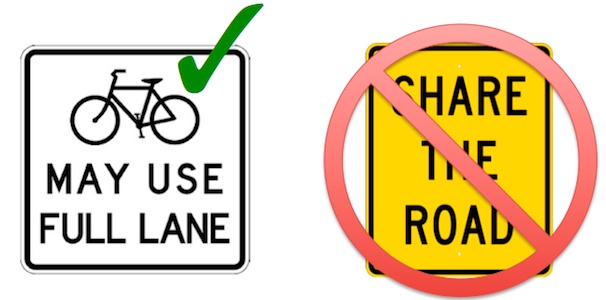
Delaware got rid of its “Share the Road” signs about two years ago. Though the signs were designed to affirm cyclists' rights to the road, they were widely misinterpreted -- by both motorists and cyclists -- as an exhortation to cyclists to stop "hogging" the road, or as a recommendation that drivers and cyclists share a lane (leading to tight squeezes and close passes).
Bike Delaware concluded that “Share The Road" is just "‘feel good’ signage that placates an interest group but has no safety benefit." And the state dumped the confusing message in favor of a less ambiguous one asserting that bicycles “may use full lane.”
A new survey confirms that Delaware had the right idea -- and other states should follow suit. In all 50 states, cyclists have a right to the road -- including the center of the lane, if that’s the safest place for them to be.
Researchers George Hess and M. Nils Peterson of North Carolina State University conducted an online survey of nearly 2,000 people to find out what various road signage means to them. On the screen, respondents were shown pictures of various traffic scenarios and street designs, and asked to interpret different signs and markings in those contexts.
When confronted with a "Share the Road" sign, a "Bicyclists May Use Full Lane" sign, or a sharrow painted on the roadway surface, did respondents think the cyclist should cede position to let the driver pass in the same lane? Should the driver wait for an opportunity to pass in the adjacent lane? Did they think it's legal for the cyclist to take the lane? Did they think it's safe?
Turns out “Share the Road” had no effect whatsoever in leading people to respect cyclists’ right to occupy a full lane of traffic. A sharrow helped a little. In the survey, by far the clearest indication that cyclists have an equal right to the road was a sign stating unequivocally that cyclists "may use full lane."
On a four-lane road, both sharrows and “May Use Full Lane” signs doubled the share of people who concluded that cyclists are allowed in the center of the lane. But on a two-lane road, neither sharrows nor “Share the Road” signs effectively communicated that motorists should wait for a gap in traffic to pass in the adjacent lane; the “May Use Full Lane” sign did.
Respondents were recruited via Twitter, and Hess and Peterson acknowledge that the pool may not be a representative sample. Participants appear to bike more and drive less than the typical American, with 80 percent saying they bike more than 16 kilometers (10 miles) per week, and 57 percent saying they don't drive solo to work. However, given the skew toward people who bike, the results suggest that if anything, Americans are more confused by "Share the Road" signage than the survey indicates.





